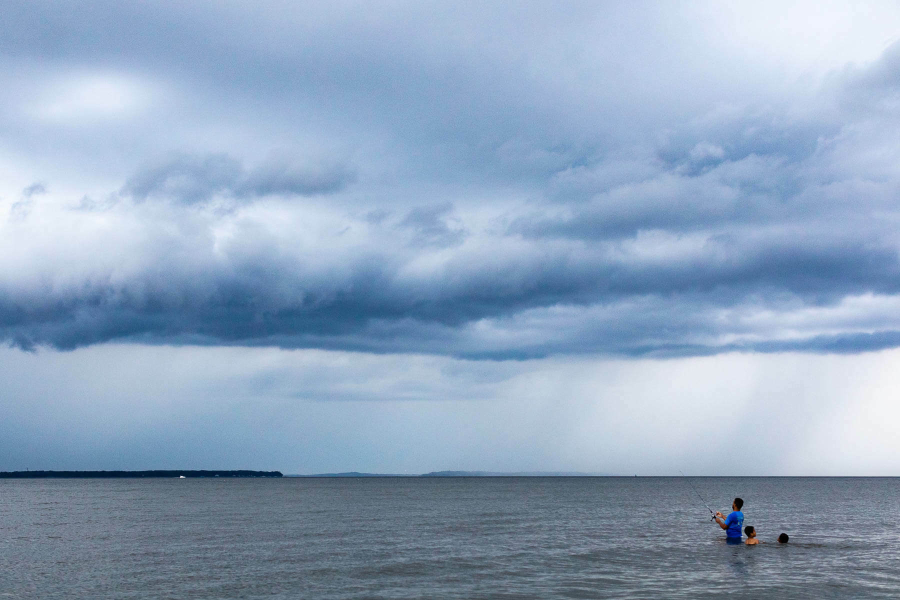Bay water quality declines, but work on the ground gives hope for the future
The Chesapeake Bay Program estimates that states, D.C. are making progress in reducing pollution

Restoring the Bay is a complex process. It requires collaboration with a variety of partners, including six different state governments, the District of Columbia, businesses, community organizations, private property owners and over 1,800 local government units, just to name a few. It means conducting state-of-the art scientific research to study, test and monitor the health of a diverse ecosystem. It’s about meeting the goals of 31 different outcomes of the Chesapeake Bay Watershed Agreement, which range from improving environmental literacy to protecting lands. But in the end, the question that is asked most often is, “how is the Bay doing?” And the simple answer today is, the Bay isn’t doing as great as it was a few years ago, but because of what people are doing to help, the future looks promising.
Two of those 31 outcomes—water quality standards attainment and the 2025 watershed implementation plans—are ways in which the Chesapeake Bay Total Maximum Daily Load (Bay TMDL) is represented in the Watershed Agreement. The Bay TMDL is overseen by the Environmental Protection Agency (EPA) and places limits on the amount of nitrogen, phosphorus and sediment pollution that each of the seven watershed jurisdictions (Delaware, the District of Columbia, Maryland, New York, Pennsylvania, Virginia and West Virginia) can discharge into the Chesapeake Bay and still have it meet water quality standards. Each of these entities has committed to putting 100% of practices in place to reduce this pollution by 2025.
The EPA develops standards to determine what the quality of a particular water body should be. It must be healthy enough for the people, animals and plants that depend on it for survival. The Chesapeake Bay Program uses this criteria as well to track the quality of the Bay’s water. In particular, the health of the Chesapeake Bay is measured by three factors:
- Water clarity: Determined by the abundance of underwater grass in the Bay. Underwater grasses require sunlight to grow, so an abundance means that sunlight is able to penetrate the water and reach the grass beds. If the water is too cloudy or murky, this wouldn’t be able to happen.
- Chlorophyll a: Causes algae to grow when there is too much of it in the water. Although algae are naturally-occurring, when there is too much in a water body and they begin to die off, their decomposition process can decrease the amount of dissolved oxygen in the water.
- Dissolved oxygen: Bay species require dissolved oxygen to live. In areas where there is little to none available, dead zones can form, hampering the plants and animals that need it for survival.
During the period of 2017—2019—the most recent year for which data is available—the water quality standards attainment of the Chesapeake Bay measured 33%, a decline from the previous assessment period (2016-2018) when it measured 38%. Since the goal is to reach 100% attainment of water quality standards, this indicates that 67% of the Bay is considered to be impaired. The experts that work at the Chesapeake Bay Program believe that this decline is due to the extraordinarily wet weather the watershed experienced in 2018 and 2019. In fact, the National Oceanic and Atmospheric Administration named 2018 as the third wettest and 2019 as the second wettest years in the United States since 1973. Excess rainfall carries even more runoff into waterways and increases the strength and amount of the flows that enter the Bay. Additional nitrogen, phosphorus and sediment pollution entering the Bay lead to increased algae growth and a decline in dissolved oxygen, which impacts the plants and animals that depend on it for habitat and food.
However, in 2020, the Chesapeake Bay Program determined that progress is happening in putting conservation practices on the ground that will eventually help decrease the amount of pollution entering the Bay. Each year, the seven watershed jurisdictions report to the EPA on what they’ve done to meet this goal. Experts then take this information, along with current land use data and manure and fertilizer information and run it through a sophisticated suite of modeling tools. The Watershed Model is then able to estimate how much nitrogen, phosphorus and sediment pollution will be reduced thanks to the practices that have now been installed.
From when the Bay TMDL was first established in 2009 to 2020, pollution controls put into place are estimated to have lowered overall nitrogen by 13%, overall phosphorus by 14% and sediment by 4%. This is an increase from the previous year for nitrogen and phosphorus, but sediment levels have remained the same. It is believed that upgrades made at wastewater facilities in how nitrogen and phosphorus is treated played a role in the decline.
The Chesapeake Bay Program estimates that enough conservation practices are in place across the watershed to reduce 47% of nitrogen, 64% of phosphorus and 100% of sediment from what is currently entering the Bay.
It’s not only large government agencies that can tackle pollution—little changes that you make at home can add up in a big way. Visit our How-Tos and Tips page for ideas on how you can help restore the Chesapeake Bay.

Comments
Has there been any studies on how the 351,000 HOAs in the USA impact the water quality of the bay ?
More specificially, HOA organisations typically have storm water management systems in 'common land'. Since most HOA are run by volunteers, many details are overlooked. Storm water management systems could be one of the details that have a large impact on the bay quality.
Thank you!
Your comment has been received. Before it can be published, the comment will be reviewed by our team to ensure it adheres with our rules of engagement.
Back to recent stories